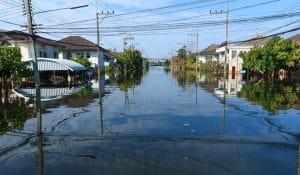 With the devastation of Hurricane Irma still fresh in our minds, many of us are probably wondering if we should purchase flood insurance before we get any strong tropical storms this year. Our regular homeowners’ policies do not cover damage from flooding (water that is rising from the ground), even it happens because of a hurricane or heavy rainfall, so investigating the costs and benefits of flood insurance is certainly worthwhile.
With the devastation of Hurricane Irma still fresh in our minds, many of us are probably wondering if we should purchase flood insurance before we get any strong tropical storms this year. Our regular homeowners’ policies do not cover damage from flooding (water that is rising from the ground), even it happens because of a hurricane or heavy rainfall, so investigating the costs and benefits of flood insurance is certainly worthwhile.
Why Have Flood Insurance
According to FEMA, flooding is the most common natural disaster in the U.S. causing millions of dollars in damage each year. The damage from just one inch of water can, in fact, cost more than $20,000, with the average payout from the National Flood Insurance Program being $43,000.
It’s no wonder then that flood insurance is required by mortgage lenders on properties located in high risk areas as well as some in moderate-to-low risk areas. Although it is not required for every home in Florida, homeowners should be aware that more than 20 percent of all flood claims come from properties that are not located in high risk flood zones. Furthermore, with flood damage, you could be talking about the difference between having the funds to repair your home and having to forfeit your home.
Types of Flood Insurance
Most flood insurance is regulated federally and offered by the National Flood Insurance Program (NFIP). To qualify for this coverage, an entire community must join and agree to hold to good floodplain management standards.
Homeowners, business owners, and renters in these communities can get affordable NFIP policies that cover buildings, the contents of buildings, or both. Building insurance covers the structure, plumbing, electrical system, central air and heating systems, cabinets, flooring and fixtures. Other structures on the property, such as pools, decks, and patios are generally not covered. Contents coverage includes the contents of the building, such as clothing, electronics and appliances.
If you don’t live in a participating community, you can purchase flood insurance from private insurers. However, some private companies limit the number or type of policies they provide (e.g., only insuring high value homes). Depending on your insurance company, flood insurance can be offered as a separate policy or as an endorsement onto your homeowner’s policy.
Cost of Flood Insurance
The cost of flood insurance varies with carrier and type, but the household average across the U.S. is $700 per year. In low to moderate risk areas, insurance can be as low as $450 for $250,000 in building coverage and $100,000 for contents. Compared to $43,000, the average flood claim payout from the National Flood Insurance Program, this seems like very little to pay.
Still, many of us would rather take our chances, thinking we won’t have to face the emotional and financial devastation of flood damage or erroneously believing that our homeowners’ policies or FEMA will protect us. Too many Americans find out too late that their homeowner’s insurance does not cover flooding, and FEMA pays on average only $4,000 to $6,000 per household.
Unless you live in a community participating in the National Flood Insurance Program or have a mortgage that requires flood insurance, the choice of whether or not to purchase flood insurance is entirely up to you. However, before making your choice, checking the cost of flood insurance in your area is a good idea.
If you have concerns about your homeowner’s or flood policy or are having problems with your insurance company, please do not hesitate to talk with an experienced insurance attorney. At Malik Law, we understand the law and the tactics insurance companies use to confuse and underpay policyholders and will advocate strongly for your rights.
Sources:
Florida Office of Insurance Regulation. Flood Insurance. https://www.floir.com/Sections/PandC/FloodInsurance/FloodInsurance.aspx
FEMA. (2018). The National Flood Insurance Program. https://www.fema.gov/national-flood-insurance-program

